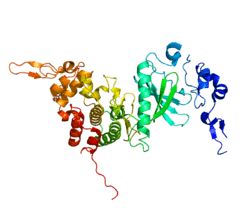DYRK2
Dual specificity tyrosine-phosphorylation-regulated kinase 2 is an enzyme that in humans is encoded by the DYRK2 gene.[5][6]
DYRK2 belongs to a family of protein kinases whose members are presumed to be involved in cellular growth and/or development. The family is defined by structural similarity of their kinase domains and their capability to autophosphorylate on tyrosine residues. DYRK2 has demonstrated tyrosine autophosphorylation and catalyzed phosphorylation of histones H3 and H2B in vitro. Two isoforms of DYRK2 have been isolated. The predominant isoform, isoform 1, lacks a 5' terminal insert.[6]
References
- 1 2 3 GRCh38: Ensembl release 89: ENSG00000127334 - Ensembl, May 2017
- 1 2 3 GRCm38: Ensembl release 89: ENSMUSG00000028630 - Ensembl, May 2017
- ↑ "Human PubMed Reference:".
- ↑ "Mouse PubMed Reference:".
- ↑ Becker W, Weber Y, Wetzel K, Eirmbter K, Tejedor FJ, Joost HG (Nov 1998). "Sequence characteristics, subcellular localization, and substrate specificity of DYRK-related kinases, a novel family of dual specificity protein kinases". J Biol Chem. 273 (40): 25893–902. doi:10.1074/jbc.273.40.25893. PMID 9748265.
- 1 2 "Entrez Gene: DYRK2 dual-specificity tyrosine-(Y)-phosphorylation regulated kinase 2".
Further reading
- Woods YL, Cohen P, Becker W, et al. (2001). "The kinase DYRK phosphorylates protein-synthesis initiation factor eIF2Bepsilon at Ser539 and the microtubule-associated protein tau at Thr212: potential role for DYRK as a glycogen synthase kinase 3-priming kinase". Biochem. J. 355 (Pt 3): 609–15. PMC 1221774. PMID 11311121.
- Strausberg RL, Feingold EA, Grouse LH, et al. (2003). "Generation and initial analysis of more than 15,000 full-length human and mouse cDNA sequences". Proc. Natl. Acad. Sci. U.S.A. 99 (26): 16899–903. doi:10.1073/pnas.242603899. PMC 139241. PMID 12477932.
- Wang X, Li W, Parra JL, et al. (2003). "The C Terminus of Initiation Factor 4E-Binding Protein 1 Contains Multiple Regulatory Features That Influence Its Function and Phosphorylation". Mol. Cell. Biol. 23 (5): 1546–57. doi:10.1128/MCB.23.5.1546-1557.2003. PMC 151707. PMID 12588975.
- Skurat AV, Dietrich AD (2004). "Phosphorylation of Ser640 in muscle glycogen synthase by DYRK family protein kinases". J. Biol. Chem. 279 (4): 2490–8. doi:10.1074/jbc.M301769200. PMID 14593110.
- Brandenberger R, Wei H, Zhang S, et al. (2005). "Transcriptome characterization elucidates signaling networks that control human ES cell growth and differentiation". Nat. Biotechnol. 22 (6): 707–16. doi:10.1038/nbt971. PMID 15146197.
- Gerhard DS, Wagner L, Feingold EA, et al. (2004). "The Status, Quality, and Expansion of the NIH Full-Length cDNA Project: The Mammalian Gene Collection (MGC)". Genome Res. 14 (10B): 2121–7. doi:10.1101/gr.2596504. PMC 528928. PMID 15489334.
- Rual JF, Venkatesan K, Hao T, et al. (2005). "Towards a proteome-scale map of the human protein-protein interaction network". Nature. 437 (7062): 1173–8. doi:10.1038/nature04209. PMID 16189514.
- Kimura K, Wakamatsu A, Suzuki Y, et al. (2006). "Diversification of transcriptional modulation: Large-scale identification and characterization of putative alternative promoters of human genes". Genome Res. 16 (1): 55–65. doi:10.1101/gr.4039406. PMC 1356129. PMID 16344560.
- Taira N, Nihira K, Yamaguchi T, et al. (2007). "DYRK2 is targeted to the nucleus and controls p53 via Ser46 phosphorylation in the apoptotic response to DNA damage". Mol. Cell. 25 (5): 725–38. doi:10.1016/j.molcel.2007.02.007. PMID 17349958.
This article is issued from
Wikipedia.
The text is licensed under Creative Commons - Attribution - Sharealike.
Additional terms may apply for the media files.






